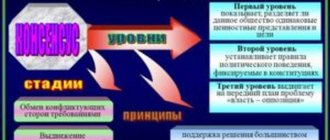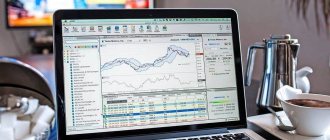The revenue received from the activities carried out forms an inflow of funds, and the summed up payments for the same time period form an outflow. Net cash flow (NCF) is the difference between inflows and outflows, and this data is reflected in the Cash Flow Statement (CFS), in which all receipts and expenses are strictly classified by the nature of operations. There are three types of cash flows: financial, investment and operating cash flows of the company.
Let's figure out how cash flow from operating activities is calculated (in the international abbreviation OCF).
Cash flow concept
Cash flow represents the receipts and costs of conducting an activity during a certain accounting period (for example, a month or a year).
Complete information about current strategies that have already brought millions of passive income to investors
This concept applies to different areas:
- In personal finance, cash flow consists of income received by a person from various sources and expenses for current activities and savings. The result of its accounting will be the difference between income and expenses (balance) at the end of the month or year.
- The same scheme operates at the enterprise, only income and expenses include more items. The balance shows profit or loss from financial and economic activities.
Economists operate on cash flow when assessing the effectiveness of an investment project. Inflows (receipts) and outflows (costs) are generated at each step of the billing period. At the end, the balance is calculated and, on its basis, various performance indicators are determined, which will answer 2 main questions:
- Will there be a return on the project and in what amount?
- When exactly will the investor receive a return on the money invested?
Cash flow is denoted by the abbreviation CF (short for cash flow), which means cash flow. In fact, not only cash is taken into account, but also all types of income and expenses.
More than 100 cool lessons, tests and exercises for brain development
Start developing
This is an important indicator that helps to understand where the money came from, what it was spent on, and whether there is anything left after all income and expense transactions. Information is needed by the management of an enterprise, a creditor, an investor, an ordinary person, if they want not only to monitor finances, but also to manage them.
In the article we will consider cash flow and its varieties from the point of view of fundamental analysis, which every investor should conduct before purchasing securities. This is one of the most important multipliers.
Structure and content of the report
For a person without special education, the document may seem quite complicated. It consists of three sections in which monetary transactions are reflected in code values according to three main indicators of the organization’s performance:
- current,
- financial
- and investment.
It should be borne in mind that not all cash movements need to be included in this document. Exceptions include :
- currency exchange transactions,
- receipt and delivery of cash to a bank account,
- exchanging cash equivalents for each other,
- transfer from one organization account to another, etc.
A complete list of actions can be found in clause 6 of PBU 23/2011.
Important feature : the report includes any financial transactions of the company. falling under its qualification requirements, regardless of the monetary units of which country they were produced in, but all data in the document is entered only in Russian rubles, and strictly in the unit of measurement (thousands, millions) that was used in drawing up the balance sheet .
Types and formulas of calculation
Cash flow is usually divided into flow from three types of activities: investing, operating and financial. For investors, two types of cash flow are of greater interest: pure and free cash flow.
Investment
Investment cash flow (denoted CFI) is associated with the investment activities of the enterprise. Includes:
- inflows, i.e. proceeds from the sale of assets;
- outflows - capital investments in construction, reconstruction, modernization and other work related to the renewal of fixed assets of the enterprise, the purchase of fixed assets and intangible assets.
Calculation formula:
CFI = Proceeds from sale of assets – Capital expenditures – Costs of purchasing financial assets
Operating
Operating cash flow (OCF) is related to current activities and reflects the ability of a business to generate real money from them. Includes:
- inflows – revenue from sales of products, works, services;
- outflows - costs for the purchase of raw materials, materials, fuel, energy, payment of taxes, payment of wages, non-operating expenses, payment of interest on loans.
Calculation formula:
OCF = EBITDA – Taxes +/– Change in working capital
Financial
Cash flow financing (CFF) is related to changes in a business's equity. Includes:
- inflows - proceeds from the issue of securities, loans received, subsidies, grants;
- outflows – loan repayments, share repurchases, bond repayments, coupon and dividend payments.
Calculation formula:
CFF = Proceeds from the issue of securities + Loans and other funds raised – Loan repayment – Bond repayment – Share repurchase – Payments on securities (coupons, dividends)
Clean
For each of the three above flows, the difference (balance) between inflows and outflows is calculated. It can be positive and negative.
The sum of the balances from investing, operating and financing activities constitutes net cash flow, i.e. NCF. The value shows how effectively the company manages its money and whether it has the funds to pay dividends to shareholders.
Calculation formula:
NCF = CFI + OCF + CFF
Free
Free cash flow (FCF) shows how much cash a business has left after paying all operating expenses and making capital investments. It is so named because it can be freely taken out of business without reducing its effectiveness.
In investments, capital expenditures are called CAPEX, so the formula for calculating FCF will look like this:
FCF = NCF – CAPEX
Example of preparing a cash flow statement
Filling out the header
Since the document is extremely important, you must be very careful when drafting it and fill out all the necessary cells.
- First, the report indicates the year for which it was compiled.
- Next, enter the full name of the organization (with the abbreviation of the organizational and legal status) and the following data:
- Date of preparation,
- OKPO code (All-Russian Classifier of Enterprises and Organizations),
- TIN,
- type of economic activity (required in the form of an OKVED code and decoding).
- Below, again, the organizational and legal form and form of ownership are entered, and next to them are the OKOPF (All-Russian Classifier of Organizational and Legal Forms) and OKFS (All-Russian Classifier of Forms of Ownership) codes.
- The last line of the document header indicates OKEI (All-Russian Classifier of Units of Measurement) codes: i.e. thousands or millions used in the report.
Filling out section 1
The first section of the document contains information about current cash flows .
- First of all, information about “receipt” : data on the total amount of funds received is entered in line 4110, which is then scattered across the underlying thematic lines - from 4111 to 4119 - in accordance with the accounting registers. This takes into account transactions from the sale of services and inventory, rental payments, interest, royalties and other “incoming” finances.
- Line 4120 indicates the total amount for payments made during the reporting period : payment of taxes and contributions to pension funds, wages, transfers to contractors and suppliers, etc. Then this amount is also posted to lines 4121 to 4129.
- the balance from current operations is entered in line 4100 (i.e., the amount of “incoming” finances minus expenses incurred).
This section also contains information about cash transfers and receipts that cannot be unambiguously classified.
An important nuance: expenses in the table must be indicated in parentheses, and excise taxes paid to suppliers and contractors, just like VAT, do not need to be included here.
Filling out section 2
The section entitled “ Cash flows from investment operations ” is completed in a similar manner. First of all, “ total receipts ” are entered in line 4210, including from the sale of shares, returns on loans, dividends, sales of non-current assets, etc., which is then posted in the required values on the corresponding lines (from 4211 to 4219).
Payments ” for investment transactions are also filled in below total is entered into line 4220 , which is then, in full accordance with the accounting registers, signed on the lines below (from 4221 to 4219), including the acquisition and other costly transactions with non-current assets, payment of interest, acquisition of debt securities, etc. .d.
Then enter the value of the balance of cash flows from all investment activities (receipts minus expenses).
Filling out section 3
The last section of the document is devoted to cash flows from various types of financial transactions . Everything is similar here:
- first, line 4310 indicates the value of “total” receipts , which is then distributed along the lower lines (from 4311 to 4319), including income from the issue of shares and bonds, loans, borrowings, etc.
- “total” indicators for financial payments are entered in line 4320, followed by their distribution in lines from 4321 to 4329.
- Then the difference between the “incoming” and “outgoing” cash flows for the reporting period for financial transactions is indicated.
- Finally, the document includes the total balance of all three cash flows for the reporting period (can be either with a plus or a minus sign), financial balances at the beginning and end of the period, as well as the difference in the exchange rate between the currencies of other countries and the Russian ruble, which is calculated using a special formula (filled in only when the organization made settlement transactions in foreign currency).
After drawing up the report, the document is submitted for approval to the head of the organization, who, with his signature, certifies the authenticity of the information included in it.
How to use cash flow in investments
For an investor, the free cash flow (FCF) indicator is of greatest interest. Its positive value indicates that the company has free money that can be used to pay dividends, repurchase its own shares from the market, and pay off debts. All of these events can affect the stock price.
A negative value means only one thing: the company spends more than it earns. But that's not always a bad thing. For example, if a company has an extensive investment program that requires significant capital investment, then the FCF will be negative. But in the long term, the investor will only benefit from the introduction of new projects.
Some enterprises can observe a situation where, according to the IFRS report, a net profit is received, and the FCF is equal to 0 or even negative. This may happen due to the method of calculating profit, which takes into account not only cash items, but also depreciation or exchange rate differences, for example. The reporting shows paper profits, while cash flow is the movement of real money.
We see an example of such a situation in Gazprom. Look at the net income and FCF numbers over the past years.
| Indicators | 2017 | 2018 | 2019 | 2020 |
| Net profit, billion rubles. | 714,3 | 1 456 | 1 203 | 0,135 |
| FCF, billion rubles | 24 | 488 | –0,6 | –261 |
If we focus only on net profit, then Gazprom receives a large amount of it every year. The only exception is the crisis year 2022. But the company did not generate real money either in 2022 or in the last 2 years.
This proves that it is impossible to evaluate the issuer only by net profit. The investor must carefully analyze all the components of cash flow and identify the reasons for its value being too large or too small.
For example, Gazprom has had a CAPEX of more than 1 trillion rubles over the past 5 years.
| 2016 | 2017 | 2018 | 2019 | 2020 |
| RUB 1,369 billion | RUB 1,406 billion | RUB 1,639 billion | RUB 1,776 billion | RUB 1,522 billion |
This is the construction of the Power of Siberia, Nord Stream 2, etc. gas pipelines. The new initiative to gasify the population (connecting a gas pipe to the house) at the company’s expense is also unlikely to lead to an improvement in the FCF indicator.
Some companies have chosen FCF as the basis for calculating dividends. For example, Alrosa, NLMK, PhosAgro. The investor can roughly calculate the amount of payments immediately after the reports are released.
Data for calculating FCF can be found in the IFRS Cash Flow Statement. For example, for Gazprom for 2022 we see the following figures.
The difference between receipts and payments in the DDS report and income and expenses
There are many differences, so receipts and incomes should not be confused. Firstly, these two concepts are most often separated in time, for example, due to a deferred payment. Secondly, not every receipt is income, and not every payment is an expense.
Example . My Defense LLC sells tea. In June, the company sold tea for 300 thousand rubles. But in fact I received the money only in August. To produce this tea, 100 thousand rubles were spent on craft bags. But the director agreed with the package manufacturer on a deferment and will pay only in July. In addition, the company took out a loan of 50 thousand rubles in July. In the table we have broken down income, expenses, receipts and payments by month.
June, rub. July, rub. August, rub. Income 300 000 Consumption 100 000 Receipt/influx 50 000 300 000 Payment/outflow 100 000
As you can see, income in the example was recognized before the money actually arrived. The same goes for expenses. But a loan is not income at all, since the money must be returned. But the loan receipt appears in the DDS report. If My Defense LLC issued a loan to someone, we would count the amount as an outflow, but not as an expense.
With barter, there will be no cash flows in principle, since money does not move. But there will be income and expenses. Income is the value of the property received, expense is the value of the property transferred.
Keep records of exports and imports in the Kontur.Accounting web service. Simple accounting, payroll and reporting in one service
Cash Flow in Personal Finance
Everything we discussed above can easily be applied to the field of personal finance. If you keep tables of income and expenses, then right now you can estimate your free cash flow. If at the end of the month it is positive for you, then I can only congratulate you and wish you its further increase.
If negative, then serious work needs to be done to eliminate this problem. And I think the lack of free money is a really serious problem. To cover the minus, you will have to borrow and forget about saving for a long time.
There are only two ways to increase cash flow: reduce expenses and increase income. When a person has already optimized his costs and there are no other options for reducing them, then all that remains is to increase the flow of money.
I advise you to read Robert Kiyosaki’s book “Cash Flow Quadrant”. The author divided all people who receive income into 4 categories.
You need to determine which quadrant you are getting your money from. This may be one or all four areas. For example, I make money in three quadrants at once: working for hire at a university, working for myself as a freelance financial writer, and investing in the stock market.
Each area requires its own knowledge and skills, each has pros and cons. But any transition from one quadrant to another is a new step in my development, which led to an increase in cash flow.
And in the image below you can see what the revenue generation methods look like in each quadrant. And only you can choose where exactly you want to be and how to earn money.
Estimation of NCF indicator values
The higher the net cash flow value, the more investment attractive the project is in the eyes of the investor and lender.
| NCF > 0 | The investment project is attractive for investment |
| NCF ≤ 0 | The investment project does not have the funds to increase its value and must be rejected |
| NCF1 > NCF2 | Investment project (1) is more attractive than (2) |











